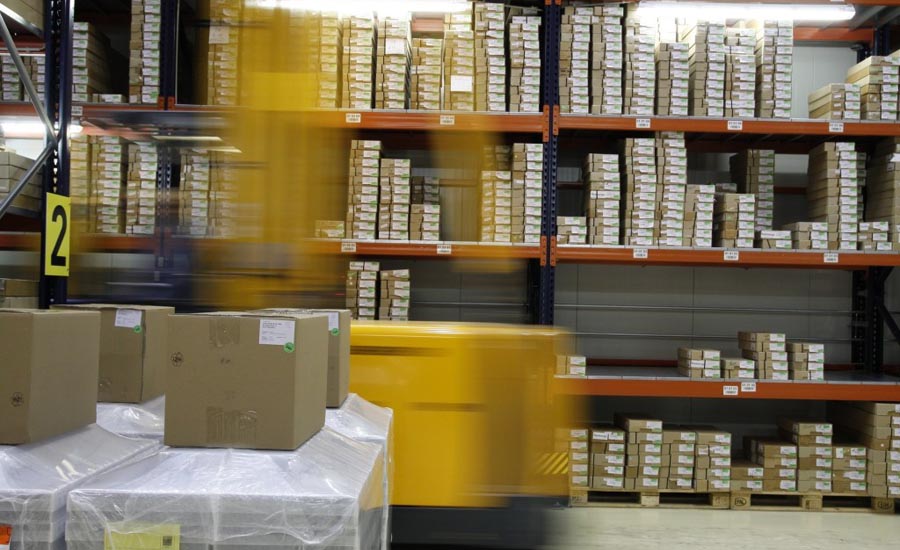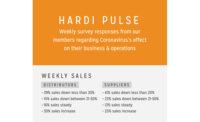COVID-19's effects on B2T distributors

As all aspects of the B2T (business-to-trades) industry are challenged with navigating their businesses through the realities of COVID-19, we had the opportunity to gain some insights on this “New Normal” as it relates to the distributor sector of our industry. We gained insights by speaking to a couple of industry experts and learned how they saw the distributor sector adapting to this new environment.
Open for business
When the pandemic first occurred, several major industrial distributors outlined COVID-19 safety precautions that they soon enacted in their facilities, including closing branches to the public except for curbside pickup, temperature screenings for all employees upon entry, staggered shifts and frequent deep cleanings. Smaller, local distributors followed suit, issuing statements on their protocols and not wanting their customers to wonder if they were still open.
“The distributors that we work with were open, but the vast majority of them locked their doors,” said Beck Oberholtzer, regional and marketing manager, at CSV Marketing, a manufacturers’ representative agency offering a diverse array of high-quality, industrial products. “If the distributor had a showroom, there was no walk-in business and they were doing touchless delivery.”
“Most of the smaller distributors were not able to send their employees home,” added Oberholtzer. “They still had employees working the phones and pulling orders, which were delivered or set outside. Some of these smaller, older-style businesses’ systems just aren’t set up to operate through the cloud. They have servers onsite and need people in the building to conduct business.”
According to Natalie Forster, editor of Supply House Times, a BNP Media brand reaching wholesalers, distributors and manufacturers’ representatives of plumbing, bath and kitchen, industrial PVF, radiant and hydronics, and HVAC products, as well as the official publication of the American Supply Association, “The biggest impact I’m seeing from the pandemic is that distributors are planning on keeping the switch to digital. Suppliers are realizing that they can be even more efficient with text-in orders and people working from home. This pandemic is going to be with us for a long time and the need for cleanliness is not going to go away. Many of the distributors, suppliers and showrooms plan to keep these changes in place.”
Forster reported that the majority of distributors had not allowed contractors to come inside when the pandemic initially hit, although it varied from state to state. Customer service, accounting and HR departments have been able to work remotely in order to keep the minimal amount of people in the showrooms and warehouses, and they have opted for drive-up, contactless service. As various states began reopening phases, suppliers implemented the typical precautions that you see elsewhere–face masks, lines on the floor and increased cleanliness.
At the beginning of the pandemic, contractors in some states, knowing that they were going to be deemed essential and that construction wouldn’t stop, came into the distributorships to obtain the supplies they needed for the remainder of their projects.
Supply chain challenges
Some suppliers had the foresight to predict that the pandemic would impact the U.S. in the way that it did, and proactively made mass orders to have surplus of inventory at hand. Other distributors didn’t have trouble getting inventory, other than the obvious PPE equipment, which was frozen by government mandates. However, others experienced minor troubles.
“The one trend that we heard, was that suppliers that get the majority of product from overseas, ran into the most problems,” said Oberholtzer. “Manufacturers that are manufacturing overseas experienced a significant slowdown.”
In recent years, especially since the “Great Recession” of ‘08, distributors have tended to be very lean on inventory levels, for the most part stocking only what they must and keeping levels low.
“It will be interesting to see how distributors will react long term,” said Bill Via, president of CSV Marketing. “Margins have been forced down with online business. Why would a supplier want to hang onto inventory any longer than they must? We see distributors looking to suppliers that are really good at JIT (just-in-time).”
Staying in touch virtually
As states are opening up, many distributors continue to be cautious.
“Some distributors are letting customers in, but they are not allowing salespeople in,” said Oberholtzer. “While others are not letting customers in but will meet with contractors on location. It varies, but salespeople ‘dropping in’ is not an option anywhere right now.”
According to recent survey stats from an HVAC buying group, when it inquired of its members whether distributor locations were seeing outside salespeople, it found that 37 percent were not allowing any in-person sales meetings, 46 percent were scheduling appointments for emergencies only, and only 16 percent were accepting in-person sales calls.
Manufacturers reps, whose entire job is interacting and building relationships with distributors and suppliers, are finding that during these unprecedented times, they must be especially creative at cultivating those relationships. The bottom line is more communication. More frequent video calls. More emails. More texts.
“Everyone is doing Zoom virtual meetings,” said Forster. “It’s so important to stay top of mind. Whereas, if you did an in-person meeting, maybe you went to a sports event and had a great time; that lingers for a while. Now, it’s important to be more proactive. And, I think the greatest challenge going forward is going to be figuring out how to maintain relationships with customers while sports events and gatherings aren’t happening.”
Due to social distancing policies, manufacturers that traditionally held distributor “Lunch & Learns,” to conduct product demos and education, are also turning to other avenues.
“We’ve also seen distributors embracing the opportunity for online training,” said Forster. “Training is more important than ever before—and it can be done virtually.”
Ramping up e-commerce
In response to the pandemic, many distributors are attempting to accelerate their efforts to revamp their e-commerce platforms. Smaller distributors that tend to be more “old school” generally haven’t implemented sophisticated e-commerce systems, if they have e-commerce at all.
“Larger distributors that had solid e-commerce platforms actually did very well so far during the pandemic, some even showed growth,” said Via. “Smaller, mom and pop distributors, who might not even have online purchasing capabilities, weren’t prepared to keep the business running off site. Those businesses have reported sales down anywhere from 30 to 80 percent, and I think they are realizing that they’ve got to proactively get e-commerce in place, or they may not survive the next pandemic.”
“I think some distributors are capitalizing on this time to ramp up (or launch) their e-commerce platforms to get them to where they need to be sales-wise,” agreed Forster.
New opportunities
While some distributors are really grateful that they were located in less populated areas that were less affected by COVID shut downs, other distributors are predicting that the industry will see an increase in acquisitions, which it has already seen for years. Some of these acquisitions will be made strictly for their customer base or for their skilled employees.
“There is a real possibility that there will be some casualties because of the pandemic,” said Via. “We are also seeing distributors that have approached manufacturers for credit relief.”
“In addition, we’re seeing manufacturers that are offering extended dating and special shipping deals like prepaid freight to ease the stress for suppliers,” added Oberholtzer.
New respect for the trades
One interesting takeaway from the pandemic that several distributors noticed is that people seemed to have gained additional respect for essential workers and the trades, that perhaps was lacking.
“We’ve had a couple of distributors submit thank you letters acknowledging plumbers and other essential workers in the trades and requesting it to be published,” said Forster. “Now, people might be thinking, ‘It’s not a bad idea to be in an essential field.’ Maybe, if we activate this in the correct way, we can turn this into a positive and help address the skilled labor shortage.”
Made in the USA
Another silver lining in the pandemic is the move towards, “Made in the U.S.”
“We think there is going to be a real serious push towards domestically made products as we move forward,” said Via. “Imported products are going to have to be the only option, or suppliers are going to have a battle on their hands. There is a very anti-Asia sentiment in the market right now.”
“Initially, the reason why manufacturers went to China was cost,” added Oberholtzer. “When you change the equation with the risks involved with another disruption, as well as customers pushing back for domestic products, it makes sense to re-examine imported products. Over the next five to 15 years, expect to see a lot more manufacturing in America when it is possible.”
It’s great to see people coming together, not just in this industry, but across all industries,” said Forster. “We’re all going through this together. We are finding more efficient ways to do things, and everyone is trying to be as productive as possible. We are going to come out of this!”
Looking for a reprint of this article?
From high-res PDFs to custom plaques, order your copy today!







